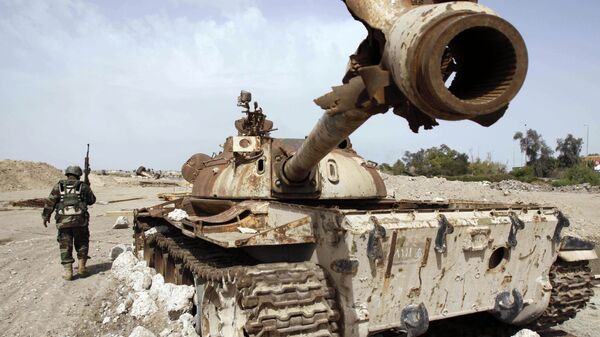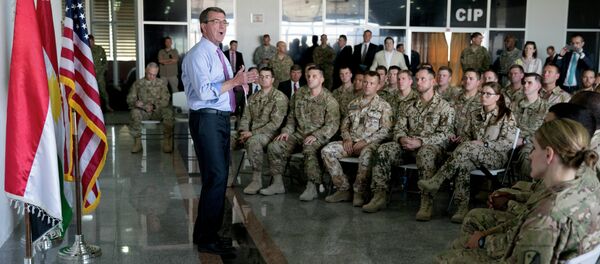Washington used intelligence reports alleging that Iraq possessed weapons of mass destruction (WMDs) to justify the invasion. No conclusive evidence of the existence of WMDs has ever been found.
Political and diplomatic preparations for the war began on January 30, 2002, when then-President of the United States George W. Bush used the expression "axis of evil" for the first time in his address to the nation. Iraq was included in the "axis" along with North Korea and Iran.
In February, then-US Secretary of State Colin Powell first spoke of the possibility of a "regime change" in Iraq.
On September 12, Bush told the UN General Assembly that Saddam Hussein posed a "serious danger," and warned of an imminent war if Baghdad refused to comply with the UN demand to disarm.
On October 17, the US Senate authorized the largest increase in military spending in over two decades, from $37.5 billion to $355.1 billion. Prior to that, Bush signed a congressional resolution authorizing the use of force against the Iraqi leader.
On the night of March 19, 2003, US and UK forces launched a joint military operation against Iraq, without UN sanction. Command and control of the offensive was exercised by US Central Command, CENTCOM, headquartered at MacDill Air Force Base, in Tampa, Florida.
A 280,000-strong combined US and UK force, based in the Persian Gulf, was engaged in the operation. The coalition Air Force had over 700 warplanes. Coalition ground forces comprised over 800 US M1 Abrams tanks, about 120 UK Challenger tanks, over 600 US M2/M3 Bradley armored fighting vehicles and about 150 UK Warrior infantry fighting vehicles.
The Iraqi armed forces had at its disposal 389,000 troops, 40,000 to 60,000 paramilitary and police formations, and 650,000 reservists. It had about 2,500 mostly obsolete tanks, some 1,500 BMP1 and BMP2 infantry fighting vehicles and about 2,000 artillery systems of caliber above 100mm. It also had about 300 warplanes, mostly French Mirage F1EQs and Soviet-designed MiGs, 100 helicopter gunships and about 300 transport helicopters.
On March 19, the US-led coalition entered a demilitarized zone on the border between Kuwait and Iraq. President Bush ordered the start of the military offensive against Iraq. The operation began the next morning with sea-launched cruise missile and air-to-surface precision guided rocket attacks on strategic Iraqi military targets and government buildings in Baghdad.
US forces used massive artillery power on the Kuwait-Iraq border. Marine expeditionary units and the 3rd Motor Rifle Division crossed the Iraq-Kuwait border and started a ground operation.
On March 20, President Bush went on air to announce the start of a military operation against Iraq.
On April 5, coalition troops advanced on a government building complex in Baghdad. In the southeast, invading forces seized the regional Iraqi capital of Basra and brought the city of Karbala, 60 miles southwest of Baghdad, fully under its control.
On April 9, coalition forces overran Baghdad and proceeded to take other major Iraqi cities, including Kirkuk and Mosul, on April 10 and 11 respectively.
On April 14, 2003, the military phase of the operation was concluded, with Hussein's home town of Tikrit falling to the coalition troops. This stage of the operation lasted just 26 days.
On May 1, 2003, Bush announced the end of the military offensive and the start of the military occupation, although the destruction of the Iraqi armed forces and Hussein’s ousting were only the beginning of a long drawn-out conflict.
After 2003, Iraq was swept by a wave of religious violence that claimed the lives of tens of thousands of innocent victims.
In November 2008, the Iraqi government and parliament approved an agreement on the withdrawal of US troops from Iraq and the regulation of their temporary presence on its territory.
On August 31, 2010, President Obama addressed the nation and declared an official end to Operation Iraqi Freedom.
On December 15, 2011, an official ceremony dedicated to the withdrawal of US troops from Iraq and the formal end of the war took place near Baghdad. US Defense Secretary Leon Panetta lowered the flag of the US military contingent in Iraq, symbolizing the completion of the mission.
On December 18, 2011, the last convoy of US troops left Iraq.
Up to 49 countries participated in OIF at different times. Aside for the US forces, the largest contingents were provided by the United Kingdom (up to 45,000 soldiers), Italy (up to 3,200), Poland (up to 2,500), Georgia (up to 2,000), and Australia (up to 2,000). Some 170,000 US troops were deployed to Iraq at the peak of the war.
Coalition forces sustained over 4,800 fatalities, of which over 4,400 were US servicemen. There are conflicting reports as to the number of Iraqi losses. US media reports have cited from 100,000 to 300,000 deaths, including among civilians, while the World Health Organization estimates that between 150,000 and 223,000 Iraqis were killed during the period 2003-2006 alone.








